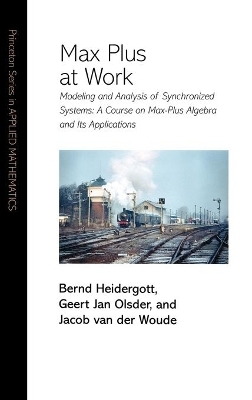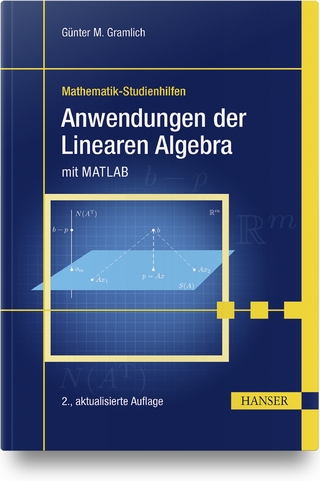
Max Plus at Work
Princeton University Press (Verlag)
978-0-691-11763-8 (ISBN)
Trains pull into a railroad station and must wait for each other before leaving again in order to let passengers change trains. How do mathematicians then calculate a railroad timetable that accurately reflects their comings and goings? One approach is to use max-plus algebra, a framework used to model Discrete Event Systems, which are well suited to describe the ordering and timing of events. This is the first textbook on max-plus algebra, providing a concise and self-contained introduction to the topic. Applications of max-plus algebra abound in the world around us. Traffic systems, computer communication systems, production lines, and flows in networks are all based on discrete even systems, and thus can be conveniently described and analyzed by means of max-plus algebra. The book consists of an introduction and thirteen chapters in three parts. Part One explores the introduction of max-plus algebra and of system descriptions based upon it. Part Two deals with a real application, namely the design of timetables for railway networks. Part Three examines various extensions, such as stochastic systems and min-max-plus systems.
The text is suitable for last-year undergraduates in mathematics, and each chapter provides exercises, notes, and a reference section.
Bernd Heidergott is Associate Professor of Mathematics and Statistics at Vrije Universiteit, Amsterdam. He is a research fellow of the Tinbergen Institute. Geert Jan Olsder is Professor of Mathematical System Theory and Deputy Vice-Chancellor at Delft University of Technology. Jacob van der Woude is Associate Professor of Mathematical System Theory at Delft University of Technology.
Preface ix Chapter 0. Prolegomenon 1 0.1 Introductory Example 1 0.2 On the Notation 3 0.3 On Eigenvalues and Eigenvectors 6 0.4 Some Modeling Issues 7 0.5 Counter and Dater Descriptions 8 0.6 Exercises 9 0.7 Notes 10 PART I. MAX-PLUS ALGEBRA 11 Chapter 1. Max-Plus Algebra 13 1.1 Basic Concepts and Definitions 13 1.2 Vectors and Matrices 17 1.3 A First Max-Plus Model 20 1.4 The Projective Space 24 1.5 Exercises 25 1.6 Notes 26 Chapter 2. Spectral Theory 28 2.1 Matrices and Graphs 28 2.2 Eigenvalues and Eigenvectors 36 2.3 Solving Linear Equations 42 2.4 Exercises 44 2.5 Notes 45 Chapter 3. Periodic Behavior and the Cycle-Time Vector 47 3.1 Cyclicity and Transient Time 48 3.2 The Cycle-Time Vector: Preliminary Results 56 3.3 The Cycle-Time Vector: General Results 62 3.4 A Sunflower Bouquet 67 3.5 Exercises 69 3.6 Notes 70 Chapter 4. Asymptotic Qualitative Behavior 72 4.1 Periodic Regimes 72 4.2 Characterization of the Eigenspace 74 4.3 Primitive Matrices 79 4.4 Limits in the Projective Space 80 4.5 Higher-Order Recurrence Relations 82 4.6 Exercises 83 4.7 Notes 84 Chapter 5. Numerical Procedures for Eigenvalues of Irreducible Matrices 85 5.1 Karp's Algorithm 85 5.2 The Power Algorithm 91 5.3 Exercises 94 5.4 Notes 94 Chapter 6. A Numerical Procedure for Eigenvalues of Reducible Matrices 95 6.1 Howard's Algorithm 96 6.2 Examples 102 6.3 Howard's Algorithm for Higher-Order Models 108 6.4 Exercises 110 6.5 Notes 111 PART II. TOOLS AND APPLICATIONS 113 Chapter 7. Petri Nets 115 7.1 Petri Nets and Event Graphs 115 7.2 The Autonomous Case 119 7.3 The Nonautonomous Case 122 7.4 Exercises 124 7.5 Notes 125 Chapter 8. The Dutch Railway System Captured in a Max-Plus Model 126 8.1 The Line System 126 8.2 Construction of the Timed Event Graph 130 8.3 State Space Description 132 8.4 Application of Howard's Algorithm 137 8.5 Exercises 138 8.6 Notes 139 Chapter 9. Delays, Stability Measures, and Results for the Whole Network 140 9.1 Propagation of Delays 140 9.2 Results for the Whole Dutch Intercity Network 145 9.3 Other Modeling Issues 148 9.4 Exercises 151 9.5 Notes 152 Chapter 10. Capacity Assessment 153 10.1 Capacity Assessment with Different Types of Trains 153 10.2 Capacity Assessment for a Series of Tunnels 154 10.3 Exercises 158 10.4 Notes 159 PART III. EXTENSIONS 161 Chapter 11. Stochastic Max-Plus Systems 163 11.1 Basic Definitions and Examples 164 11.2 The Subadditive Ergodic Theorem 167 11.3 Matrices with Fixed Support 171 11.4 Beyond Fixed Support 174 11.5 Exercises 175 11.6 Notes 176 Chapter 12. Min-Max-Plus Systems and Beyond 177 12.1 Min-Max-Plus Systems 177 12.2 Links to Other Mathematical Areas 187 12.3 Exercises 189 12.4 Notes 190 Chapter 13. Continuous and Synchronized Flows on Networks 191 13.1 Dater and Counter Descriptions 191 13.2 Continuous Flows without Capacity Constraints 192 13.3 Continuous Flows with Capacity Constraints 197 13.4 Exercises 199 13.5 Notes 200 Bibliography 201 List of Symbols 206 Index 209
| Erscheint lt. Verlag | 27.11.2005 |
|---|---|
| Reihe/Serie | Princeton Series in Applied Mathematics |
| Zusatzinfo | 9 halftones. 36 line illus. |
| Verlagsort | New Jersey |
| Sprache | englisch |
| Maße | 152 x 235 mm |
| Gewicht | 425 g |
| Themenwelt | Mathematik / Informatik ► Mathematik ► Algebra |
| ISBN-10 | 0-691-11763-2 / 0691117632 |
| ISBN-13 | 978-0-691-11763-8 / 9780691117638 |
| Zustand | Neuware |
| Haben Sie eine Frage zum Produkt? |
aus dem Bereich


